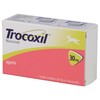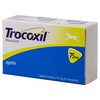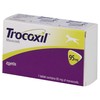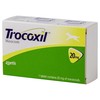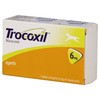Trocoxil
Trocoxil Chewable Tablets are for the treatment of pain and inflammation associated with degenerative joint disease in dogs over 12 months old. Degenerative joint disease is indicated where continuous treatment exceeding one month is needed.
Trocoxil Tablets are triangular in shape with a mottled brown appearance. They are available in various strengths, which is embossed onto one side of the tablet.
Trocoxil 30mg Chewable Tablet for Dogs
£12.49Trocoxil 30mg Chewable Tablets are for the treatment of inflammation and pain linked with degenerative joint disease. Degenerative joint disease can be found in dogs aged 12 months or...[More info]
Trocoxil 75mg Chewable Tablet for Dogs
£22.26Trocoxil 75mg Chewable Tablets are for the treatment of inflammation and pain linked with degenerative joint disease. Degenerative joint disease can be found in dogs aged 12 months or...[More info]
Trocoxil 95mg Chewable Tablet for Dogs
£33.28Trocoxil 95mg Chewable Tablets are for the treatment of inflammation and pain linked with degenerative joint disease. Degenerative joint disease can be found in dogs aged 12 months or...[More info]
Trocoxil 20mg Chewable Tablet for Dogs
£11.24Trocoxil 20mg Chewable Tablets are for the treatment of inflammation and pain linked with degenerative joint disease. Degenerative joint disease can be found in dogs aged 12 months or...[More info]
Trocoxil 6mg Chewable Tablet for Dogs
£8.20Trocoxil 6mg Chewable Tablets are for the treatment of inflammation and pain linked with degenerative joint disease. Degenerative joint disease can be found in dogs aged 12 months or older,...[More info]
Dosage and administration
For oral use.
THIS IS NOT A DAILY NSAID. The dose is 2 mg mavacoxib per kg bodyweight given immediately before or with the dog's main meal. Care should be taken to ensure that the tablet is ingested. The treatment should be repeated 14 days later, thereafter the dosing interval is ONE MONTH. A treatment cycle should not exceed 7 consecutive doses (6.5 months).
Contra-indications, warnings, etc
Do not use in dogs less than 12 months of age and/or less than 5 kg bodyweight.
Do not use in dogs suffering from gastro-intestinal disorders including ulceration and bleeding.
Do not use where there is evidence of a haemorrhagic disorder.
Do not use in cases of impaired renal or hepatic function.
Do not use in cases of cardiac insufficiency.
Do not use in pregnant, breeding or lactating animals.
Do not use in cases of hypersensitivity to the active substance or to any of the excipients.
Do not use in cases of known hypersensitivity to sulphonamides.
Do not use concomitantly with glucocorticoids or other NSAIDs.
Do not administer other NSAIDs within 1 month of the last administration of Trocoxil.
Mavacoxib exhibits an extended plasma half life due to its low rate of elimination. This corresponds to a duration of effect of 1-2 months after administration of the second dose (and following doses). Care should be taken to avoid treatment of animals that might not tolerate prolonged NSAID exposure. A maximum treatment administration of 6.5 months continuous therapy is recommended so as to manage plasma levels of mavacoxib in animals which exhibit reduced elimination.
Animals should undergo a thorough clinical examination before commencing treatment with Trocoxil and appropriate laboratory tests to monitor haematology and clinical chemistry are recommended. Animals with evidence of impaired renal or hepatic function, or with evidence of a protein or blood-losing enteropathy are not suitable for treatment with Trocoxil. It is recommended to repeat the clinical examination one month after commencing treatment with Trocoxil and prior to administration of the third dose with additional monitoring of clinical pathology as appropriate during treatment.
Mavacoxib is excreted via bile and in dogs with hepatic disorders reduced elimination and thus excessive accumulation could occur. For this reason dogs with hepatic disorders should not be treated.
Avoid use in any dehydrated, hypovolaemic or hypotensive animal, as there is a potential risk of increased renal toxicity. Concurrent administration of potentially nephrotoxic medicinal products should be avoided.
Ensure appropriate hydration and haemodynamic status when animals receiving Trocoxil undergo anaesthesia and/or surgical procedures or develop conditions which may result in dehydration or compromised haemodynamic status. The key aim of intervention is to maintain renal perfusion. Patients with underlying renal disease may experience exacerbation of decompensation of their renal disease while on NSAID therapy.
Adverse reactions of the digestive tract such as vomiting and diarrhoea were commonly reported, loss of appetite, haemorrhagic diarrhoea and melaena have been reported in uncommon cases. Gastrointestinal ulceration was reported in rare cases. Apathy, degradation of renal biochemistry parameters and impaired renal function has been reported in uncommon cases. In rare cases these may be fatal.
If an adverse reaction to the administration of Trocoxil occurs, no further tablets should be administered and general supportive therapy, as applied to clinical overdosage with NSAIDs, should be applied. Particular attention should be paid to maintaining haemodynamic status. Gastrointestinal protectants and parenteral fluids, as appropriate, may be required for animals that experienced gastrointestinal or renal adverse reactions. Veterinarians should be aware that clinical signs of adverse reactions may continue when supportive therapy (such as gastro protectants) is discontinued.
Do not use in pregnant, breeding, or lactating animals. The safety of Trocoxil has not been established during pregnancy and lactation. However, studies in laboratory animals administered other NSAIDs have shown increased pre- and post-implantation loss, embryo-foetal lethality, and malformations.
No drug interaction studies have been performed. In common with other NSAIDs, Trocoxil should not be administered simultaneously with other NSAIDs or glucocorticosteroids. Risks for interactions have to be accounted for throughout the effect period i.e. 1-2 months after administration of Trocoxil. Dogs should be carefully monitored if Trocoxil is administered simultaneously with an anticoagulant.
NSAIDs are highly bound to plasma proteins and may compete with other highly bound substances, such that concomitant administration may result in toxic effects. Pre-treatment with other anti-inflammatory substances may result in additional or increased adverse effects. To avoid such effects when Trocoxil is to be administered in replacement of another NSAID, ensure an appropriate treatment-free period of at least 24 hours before administering the first dose of Trocoxil. The treatment-free period should however, take into account the pharmacology of the medicinal products used previously. Should another NSAID be administered after Trocoxil treatment, a treatment-free period of at least ONE MONTH should be ensured to avoid adverse effects.
In the overdose studies, in common with other NSAIDs, adverse pharmacodynamic events occur affecting the gastrointestinal system. Similarly adverse reactions occurring at the use dose in the animal population principally involved the gastrointestinal system.
In overdose safety studies, repeated doses of 5 mg/kg and 10 mg/kg were not associated with adverse clinical events, abnormal clinical chemistry or significant histological abnormalities. At 15 mg/kg there was evidence of vomiting, and softened/mucoid faeces and an increase in clinical chemistry parameters reflecting renal function. At 25 mg/kg there was evidence of gastrointestinal ulceration.
There is no specific antidote for mavacoxib overdosage, but general supportive therapy, as applied to clinical overdosage with NSAID's, should be given.
Operator Warnings
In case of accidental self-administration, seek medical advice immediately and show the package leaflet or the label to the physician.
Ingestion of Trocoxil may be harmful for children, and prolonged pharmacological effects leading to e.g. gastrointestinal disorders may be observed. To avoid accidental ingestion administer the tablet to the dog immediately after removal from the blister packaging.
People with known hypersensitivity to NSAIDs should avoid contact with the veterinary medicinal product.
Do not eat, drink, or smoke when handling the product. Wash hands after handling the product.
